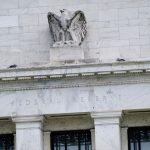(Reuters) -Federal Reserve policymakers got more evidence of U.S. labor-market cooling on Friday that could boost their confidence they are winning their fight on inflation, and open the path to a more active debate on interest-rate cuts when they next meet in late July.
The Labor Department report showing a rise in unemployment and a decline in job creation is just the latest in a string of recent data offering more evidence of slowing than what U.S. central bankers had in hand at their June meeting.
At that time, many of them felt inflation progress was so lacking and the economy still so strong that they would likely cut rates only once this year, if at all. Since then, the data has marched in the opposite direction. A couple of inflation reports have shown prices did not rise at all from April to May; other reports have signaled a slump in services and manufacturing activity and rising job openings and layoffs.
Friday’s job report did not show big cracks in the labor market – indeed, job gains in June, at 206,000, outpaced economists’ expectations.
But the unemployment rate rose to 4.1%, and large revisions to prior-month estimates of job creation meant the average monthly payroll gain over the most recent three months has downshifted to 177,000.
That’s below the 200,000-a-month gain that Fed Governor Lisa Cook recently estimated the economy now needs just to keep up with immigration and other increases to the population.
Average hourly earnings were up 3.9% from a year earlier, and 0.3% from a month earlier, Friday’s report showed. That puts annualized wage growth for the last three months at about 3.6%, nearing a pace consistent with the Fed’s 2% inflation objective.
U.S. central bankers meeting July 30-31 are not expected to change their policy rate from the 5.25%-5.5% range it has been in since last July.
But the new data, which suggests the labor market is nearing a healthier balance, could put a rate cut at the following meeting in their sights.
“Overall, a moderation in payrolls in Q2 coupled with a rise in the unemployment rate and a slower growth path suggested by recent data bolster the case for rate cuts this year,” said Rubeela Farooqi, chief U.S. economist of High Frequency Economics. “We think the Fed could certainly start the discussion about cutting rates at the upcoming FOMC meeting, and lower the policy rate in September, if the data continue to show moderation.”
Fed policymakers at their June meeting signaled they see just one interest-rate cut this year, a forecast that pointed to a December start to any policy easing.
Fed Chair Jerome Powell said they would need to be confident inflation is heading to their 2% goal before cutting rates.
He also said any unexpected weakening in the labor market could also trigger a rate cut.
The increase in the unemployment rate last month from 4% still leaves that widely used gauge of labor-market health below levels historically associated with a downturn.
But the rising rate, which was 3.7% in January and 3.5% last July, paints an economy on a more fragile footing than the raw number might suggest. Unless it declines in July, it would trigger what’s known as the Sahm rule, an indicator for recession.
And while the post-pandemic economy has repeatedly bucked expectations and undercut long-held correlations, analysts are wary.
“We now have definitive evidence of U.S. labor market cooling with a somewhat alarming rise in the unemployment rate in recent months that should give policymakers ‘more confidence’ that consumer inflation will soon return to the 2% target on a sustainable basis,” said BMO Chief U.S. Economist Scott Anderson.
Powell is slated to address Congress on Tuesday and Wednesday, and investors will be paying close attention to his views on the latest data and what it means for the Fed’s policy path.

On Thursday investors will get the June reading on the consumer price index, which last month showed inflation had resumed its cooling trend.
Financial markets are pricing in a 78% chance of a September rate cut, up from about 72% before the June jobs report. Traders are also pricing in a second rate cut in December more firmly than previously.
To read the full article, Click Here

